
Rand Paul’s Brilliant Plan to Solve the Health Insurance Crisis
The Affordable Care Act (Obamacare) was sold as a way to bring health care to millions by eliminating pre-existing condition discrimination and stabilizing the insurance markets. Yet, more than a decade in, it’s become painfully clear that what it didn’t fix, and what it made much worse, is our crushing cost crisis. Premiums are still climbing, deductibles are high, and the “help” from the federal government now comes with a lethal price tag: deficits and national debt that threaten the very foundation of our fiscal system.
Obamacare may have expanded access, but it failed in every other regard. For many Americans, especially those in the gig economy, self-employed, or working for very small businesses, insurance remains unaffordable or almost unusable. Even after subsidies, premiums on the ACA exchanges have soared over the years, and out-of-pocket costs like deductibles and co-pays continue to strain the budgets of middle-class families.
ACA’s affordability problem was masked for several years by the temporary COVID-era subsidies created under the American Rescue Plan in 2021. These expanded tax credits were explicitly sold to the public as an emergency measure to help families weather the pandemic. They were never meant to be a permanent restructuring of the healthcare system. Yet instead of letting them expire, Congress extended them through 2025 under the Inflation Reduction Act, effectively turning a crisis-era patch into another permanent Democrat welfare program.
What was supposed to be short-term relief has now become another layer of costly subsidies the nation cannot afford, pushing deficits even higher and making the ACA more dependent than ever on federal spending that was never meant to last. ACA’s premium tax credits and cost-sharing reductions do help people, but they also place enormous pressure on the federal budget. With mounting deficits and an ever-growing national debt, the question becomes unavoidable. Can we keep writing blank checks for health care indefinitely?
Of course not.
Rand Paul and the Creative Cure for Skyrocketing Health Insurance Premiums
Senator Rand Paul argues that we’re on an unsustainable path, and continuing to rely on massive federal subsidies is a reform dead end. He has long warned that unless patients are reconnected to prices and genuine competition, no amount of government spending will fix the underlying dysfunction. In an interview with CBS News, Paul was blunt:
“Until you connect the consumer to price, until you have real competition and capitalism… the marketplace will be broken. Obamacare cost too much, mandated too much … and still left 27 million people uninsured.”
This fiscal reality is central to Paul’s philosophy on healthcare. Federal spending already consumes a staggering share of the budget. Continuing to expand subsidies year after year is not simply a policy question but a matter of national solvency. Paul’s reform approach is grounded in the belief that instead of relying on taxpayers to fill the gap, policymakers should empower people to take advantage of the same cost-lowering mechanisms that large corporations use every day.
This is where Rand Paul’s signature solution becomes transformative by allowing large membership organizations to negotiate health insurance the same way major employers do. Under his Association Health Plans Act, groups like Costco, Sam’s Club, Amazon, trade associations, credit unions, churches, and even newly formed membership groups could offer ERISA-style health insurance across state lines. The idea is to allow ordinary Americans to benefit from the same economies of scale that Fortune 500 companies use to secure affordable coverage for their employees.
Paul illustrated the power of this idea with a simple example:
“I like to let people buy it through an entity like Costco, which has 44 million members… someone from Costco would negotiate for 44 million members and have the leverage to drop prices down This is the idea of legalizing the ability to buy your health insurance through Costco, Sam’s or Amazon… Imagine if one person negotiated for 44 million members — how you’d drive prices down.”
Shifting purchasing power away from government exchanges and toward large, voluntary membership groups would unleash true market competition. Instead of individuals shopping alone on narrow, regulated, inefficient government marketplaces, millions could band together and demand better prices, better coverage, and simpler plans without an endless stream of new federal spending. Paul’s legislation prohibits discrimination based on health status and requires plans to cover people with pre-existing conditions.
What makes Paul’s vision compelling, especially in the current fiscal environment, is the way it blends personal freedom with long-term sustainability. Rather than doubling down on more government spending or expanding bureaucracy, his plan offers a path where people organize themselves, join groups that reflect their lives and values, and harness collective bargaining power that has so far been reserved only for large employers.
Paul summed up his philosophy succinctly:
“My plan puts more power in the people’s hands, getting rid of unnecessary restrictions, expanding access, and trusting Americans to make the decisions that are best for them.”
It is a refreshingly empowering message in a time when Washington often assumes only bigger government can solve big problems.
Everyone knew Obamacare was a disaster in the making before the legislation was passed. No matter what it touches, government almost always makes it more broken than they found it. The subsidies that made it remotely workable are becoming fiscally unsustainable, and the federal government cannot continue spending trillions without jeopardizing America’s long-term financial stability. America still refuses to wake up to the reality that we are broke and can no longer afford to borrow from China and Japan to finance more free money giveaways.
Rand Paul’s proposal offers a different path in that it rejects the false choice between government dependency and unaffordable private insurance. Instead, it gives power back to millions of Americans as they negotiate together.
The potential rewards to Paul’s plan are enormous. Imagine lower premiums, more choices, and a system built on empowerment rather than debt. In a moment when Washington is trapped between expanding subsidies or accepting rising costs, Rand Paul’s approach offers something increasingly rare. It is a bold idea rooted in fiscal responsibility, competition, and faith in the American people.



